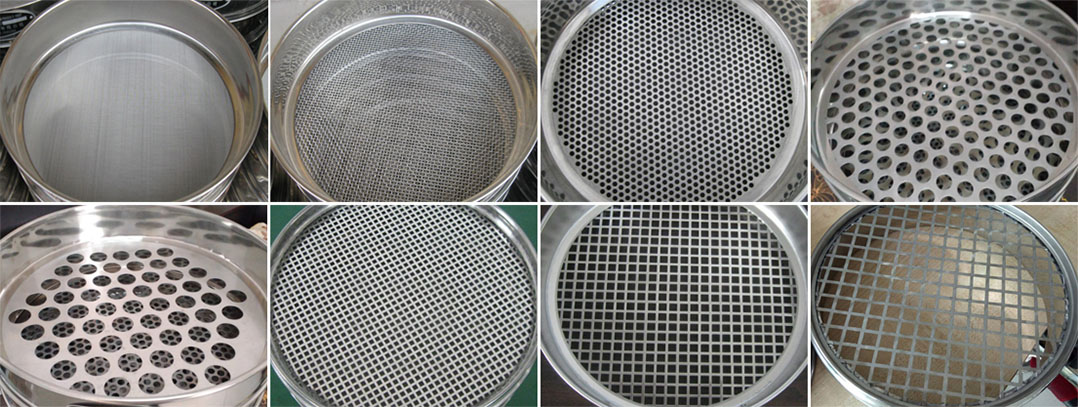Woven wire mesh (widely used meshes ranging from 2.36 mm to 0.02 mm only have square meshes)
Perforated plate screen (mainly used in large meshes, with round and square meshes ranging from 0.2 to several hundred millimeters);
Woven wire, usually square mesh, the most common type of screen
Perforated plate screen (mainly used in large meshes, with round and square meshes ranging from 0.2 to several hundred millimeters)
It is made by mechanical punching of metal plate, the mesh is usually square or round, with good flatness and high compressive strength, suitable for soil and rock sample testing
Electroforming screen (mainly used in high-precision occasions, each mesh can be within the average error range).
The finest sieve type, the mesh is extremely fine, only suitable for the analysis of a small amount of light and thin samples, and it is forbidden to handle heavy objects to cause rupture

Stainless steel laboratory test sieve: The most common type of stainless steel material, the sieve frame is polished, smooth and rust-free, and the sieve is flat, suitable for sieving of most samples.
Brass laboratory test sieve: It has strong wear resistance and good chemical corrosion resistance. It can detect and analyze some materials with high hardness and special chemical properties. It can be used in medicine, food, chemical industry, geology and other industries.
Nylon laboratory test sieve: all made of PVC material, anti-corrosion nylon mesh, no metal, no magnetism, no static electricity. Handle sample materials that cannot be in contact with metals, such as: zirconium oxide, fluorescent powder, and some special chemical additives, etc.
1. The laboratory test sieve of various materials can be selected according to the characteristics of the sample and can be customized.
2. The material is stretched and formed at one time, non-magnetic, with precise coordination, no material leakage, wall thickness 0.6mm, durable and no deformation, polished surface, exquisite and beautiful.
3. The screen and the screen frame are connected by welding, which can withstand 400° high temperature, and can be used for inorganic and organic solutions.
4. In line with ISO3310 standards, the product model is accurate and can be nested.

| Items | Name | Unit | Data |
| 1 | Layers | layer | 1-8 |
| 2 | Diameter | mm | 200, 300 |
| 3 | Sieve frame | mm | 100, 200, 300, 400 |
| 4 | Noise | db | below 50 |
| 5 | Feeding Capacity (Once) | g | <200 g/ml |
| 6 | Amplitude | mm | <5 |
| 7 | Voltage | v | 220 v / customized |
| 8 | Power | kw | 0.125 |
| 9 | Overall Dimension | mm | 450*410*700 |
| 10 | Weight | kg | 60 |
| No. | Type | Mesh(mm) | No. | Type | Mesh(mm) |
| 1 | 8# | 2.360 | 15 | 70# | 0.212 |
| 2 | 10# | 2.000 | 16 | 80# | 0.180 |
| 3 | 12# | 1.700 | 17 | 100# | 0.150 |
| 4 | 14# | 1.400 | 18 | 120# | 0.125 |
| 5 | 16# | 1.180 | 19 | 140# | 0.106 |
| 6 | 18# | 1.000 | 20 | 170# | 0.09 |
| 7 | 20# | 0.850 | 21 | 200# | 0.075 |
| 8 | 25# | 0.710 | 22 | 230# | 0.063 |
| 9 | 30# | 0.600 | 23 | 270# | 0.053 |
| 10 | 35# | 0.500 | 24 | 325# | 0.045 |
| 11 | 40# | 0.425 | 25 | 400# | 0.038 |
| 12 | 45# | 0.355 | 26 | 500# | 0.028 |
| 13 | 50# | 0.300 | 27 | >500# | <0.028 |
| 14 | 60# | 0.250 |
Common material reference: select the number of screen meshes according to the material

| Cassia | 14 mesh | Buckwheat | 12 mesh | Tenebrio molitor eggs | 12 mesh |
| Worm dung | 30 mesh | Soybeans | 4-5 mesh | green beans | 10 mesh |
| Rice | 12-14 mesh | rice flour | 30-40 mesh | Cornmeal | 30-40 mesh |
| flour | 50-60 mesh | Miscellaneous grains | 40-50 mesh | Sesame Millet | 22-24 mesh |
| Fried Chicken Burger Breaded | 20-30 mesh | Mung bean flour | 40-50 mesh | Sesame powder | 40-50 mesh |
| Notoginseng powder | 100-120 mesh | Pine pollen | 100-120 mesh | Chinese medicine powder | 40-50 mesh |
| Oral Chinese medicine powder | 60-80 mesh | Traditional Chinese Medicine Mask | 80-120 mesh | Pearl powder | 120-150 mesh |
| Medicine residue | 60-150 mesh | Soy milk | 80-120 mesh | honey | 80-120 mesh |
| Soup dregs | 120-150 mesh | Tea water | 120-150 mesh | Cooking oil | 150-200 mesh |

laboratory test sieves for flour
laboratory sieve shaker for aggregate
How to use laboratory test sieves